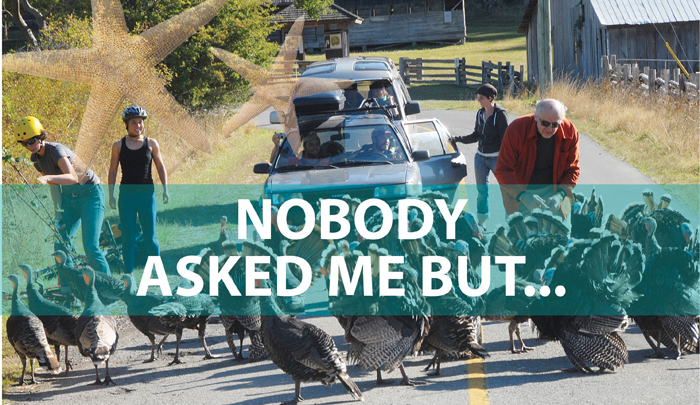First of all, a little disclaimer. If you are weak in the stomach or have a hard time watching gruesome scenes, it would be best for you to just turn the page and read another article. This column details the shocking true confessions about the sordid activities that are carried out regularly deep within the innards of your compost bin.
On the surface, the principles of composting seem quite simple. For most people, it’s just a matter of scraping unwanted food off your plates into a bucket and then tossing these leftovers and table scraps into a pile somewhere outside your dwelling. Of course you can accessorize your compost with some of those questionable food items that have found their way onto the door of your fridge or far back on some of the lower shelves.
You know what I’m talking about: besides the obvious milk that has soured and the curdled cream, there’s that tube of anchovy paste that was used just once back before the turn of the millennium; the browning block of tofu that is well past its “best before” date; all those jars of homemade relish, chutneys and jams whose labels have long ago decomposed and peeled off and which are now incubating some kind of alien species of lime-green mold; and, of course, the ubiquitous scuzzy plastic baggie filled with slimy decaying cilantro that just kept sitting in your refrigerator because nobody wanted to deal with it.
Some food scraps are better left out of the compost and disposed of some other way. Leftover de-kernelled corn cobs, for instance, seem to survive unchanged for decades and will probably still be intact when future archaeologists come digging for signs of civilization. Banana peels sporting brand name sticky labels such as Chiquita and Del Monte are also troublesome as there is a chance these labels may reappear where you least likely expect (like inside a head of cabbage). Bones are another no-no. Turkey bones have more of a chance of growing into new turkeys than breaking down to produce nutrient-rich soil.
The object of composting, I repeat, is to create an environment where the cellular structures of living organisms break down into simpler building blocks which when mixed together provide the ideal medium for plant growth. For this reason, you also don’t want to include items that will feed and grow instead of decay. Notorious for this kind of misbehaviour are avocado pits, which revel in the ability to split apart, thusly allowing new growth to sprout from the inner core. Uncooked potato bits act in a similar manner and, if you are not careful, may take over your compost bin and turn it into next year’s spud patch.
If all goes according to plan, you hope all this decaying organic matter that didn’t make it into your pie hole will miraculously turn into rich nutritious soil that will nourish a new crop of fruit, vegetables and lush greenery. The key to making this happen is layering and not allowing the compost to dry out. Layering means piling different strata of organic non-food materials, such as sawdust, wood ash, kelp and other types of seaweed, and shredded newspaper flyers advertising special sales that have long ago expired, on top of one another. You can also use dead leaves, grass clippings, biochar and half-chewed apples left behind by renegade deer that have breached your fence line.
There’s a lot going on in your compost once you scrape below the surface. Not all veggies get along with each other. You’ve probably heard of companion planting where some vegetables grow better when in proximity to others. Well, the same thing is true inside your compost. Leafy vegetables prefer to stay clear of root crops. Pineapples would rather not mix with other fruit that grow on trees. Kumquats are generally snobby while artichokes wear their hearts on their sleeves. Nobody wants to be anywhere near the hot peppers, and the pole beans are looked on derisively as freeloading hangers-on. Broccoli are pretty laid-back and spend most of their decaying time pondering the moral dilemma of whether their name is spelled with two C’s and one L or the other way around.
Of course, the entire sociological order and class system of the common pile of compost is thrown into total disarray when you decide it’s time to turn the compost. Not only are the decaying morsels of matter upended topsy-turvy into a state of confusion, but the worms, insects and microbes which do the heavy lifting in your compost are stunned into suspended animation for a few days.
Nevertheless, when order is restored, the earthworms, flies and bacteria, working together in unison, return to break down the solids into smaller particles which can then undergo chemical reactions to help move along the process of soil building. In fact, the earthworms release castings, an organic form of fertilizer also known as “worm poo,” that enrich the compost and improve soil aeration, drainage, as well as water retention.
There you have it: the secret life of compost.
Nobody asked me, but it’s fair to conclude that your compost bin can be seen as a microcosm for the world at large. In fact, the earth is really one big heap of compost. Sure, it can get smelly sometimes, but if you just mix a little bit of this with a little clump of that, give it a stir, keep it moist and let it heat up with its own energy, you will find that decay transforms into growth. That’s how it goes: as the compost turns.

